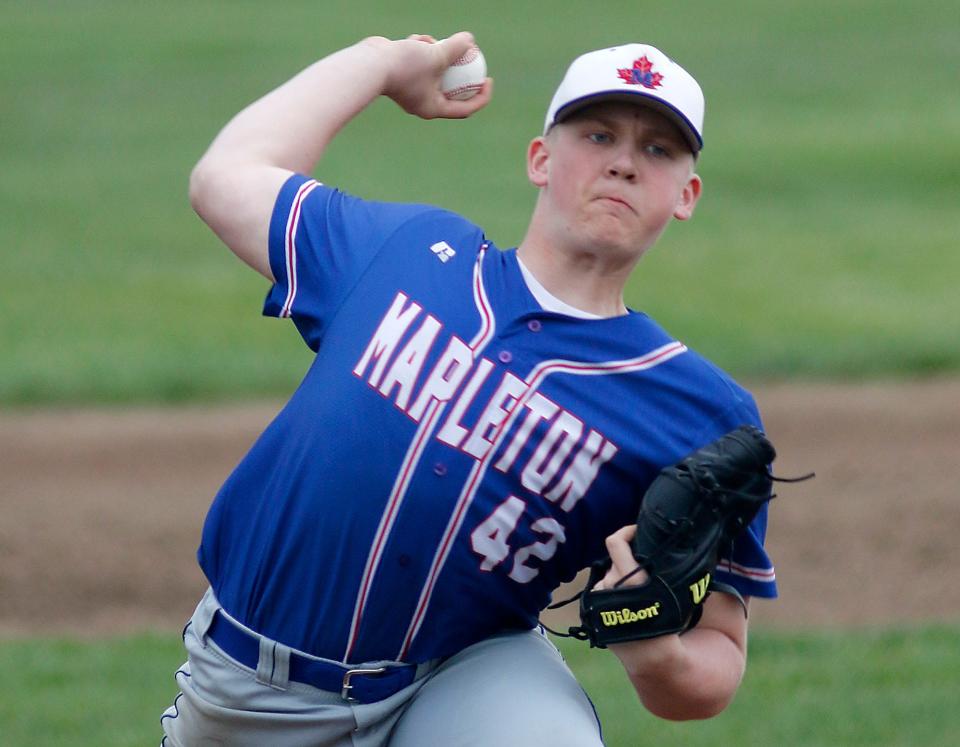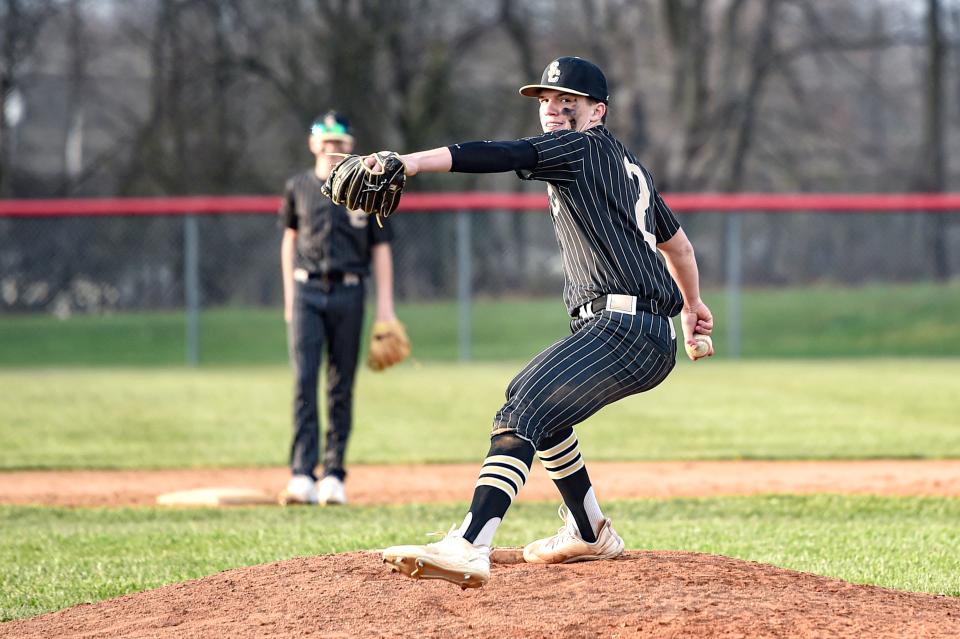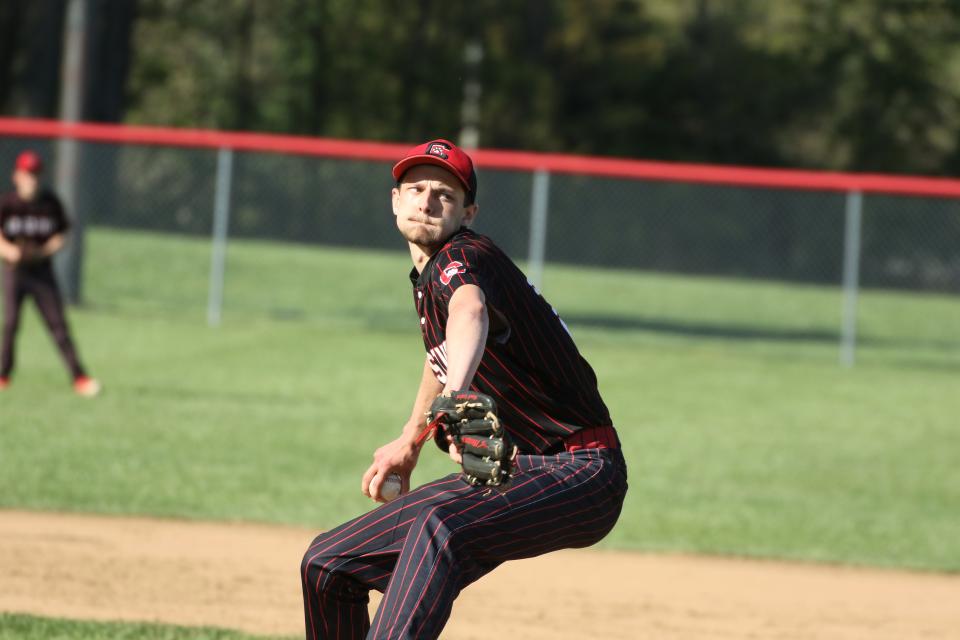Examining the increase in arm injuries at the high school baseball level
ASHLAND − If you are a devoted baseball fan, then you're probably aware of the frequent uptick in arm injuries that pitchers all the way from the high school level to the major league level have been suffering over the past few years. Those injuries have led to pitchers having to get the dreaded Tommy John surgery or if the injury is severe enough, they end up not pitching the rest of their respective season. And it seems to only be increasing.
Many are calling it an epidemic. A baseball crisis. Asking, how it can be solved?
Regarding this issue, the Ashland Times-Gazette tackled it on the high school level in Ashland County. We spoke with a few coaches and pitchers to see how they are addressing the rise on arm injuries for pitchers, their thoughts and what they might think the main problem is.
More: Ashland County Baseball Power Rankings: South Central, Hillsdale, Ashland fight for No. 1
Why the arm issues?
When it comes to why there has been such a jump in arm injuries with pitchers at the major league level, most experts/media members have said pitchers are throwing too hard, are using too much spin when throwing curveballs and breaking pitches, are being overused, are not getting the proper rest before or after they pitch in a game and the implementation of the new pitch clock (pitchers have fewer seconds between pitches) that's aimed to get through games faster. Those same arm injury issues have seemed to trickle down to the high school level as well.
Crestview head coach Don Keener and Mapleton head coach Aaron Welch attribute some of the arm injuries with younger kids to the fact that they are playing more baseball year-round.
"I don't think the pitch count is too high. The kids play a lot of baseball," said Keener. "They're playing a lot more summer ball. Kids are traveling more, so you're going to be in more games. You're going to need more kids to pitch, which means more innings. Maybe there's an overuse when they're throwing a lot more than they are used to."
"I think part of it is throwing with so much velocity," said Welch. "Kids are throwing harder than they were 10 years ago. They're throwing harder at a younger age. They're playing travel ball and throwing a lot more over the summer."

"It would have been two years ago. Karl Ferber, who was a pitcher for us. He ended up tearing his UCL (Ulnar Collateral Ligament)," said South Central head coach Nick Kirk. "He had to have Tommy John surgery. He played his senior year but wasn't able to pitch. He actually went to Lake Erie College (Painesville, Ohio) to play baseball and had tingling in his hand, so he had to have surgery again. He redshirted this year. We started to monitor it a lot more since that happened two years ago. You notice it throughout all of baseball. They did the pitch clock and who knows if it's got anything to do with it. A lot of people are throwing harder than they did back then."
The pitchers notice the constant arm injuries too, more so with teammates or opposing pitchers they face.
"I wasn't real worried about arm health but it came as more of a concern for me when it happened to some of my teammates," said South Central pitcher Aaron Hauler.
"Some of the kids we've played are dealing with some arm injuries," said Crestview pitcher Jarek Ringler. "One of our conference teams had to pull their best pitcher after the first inning because he was complaining about his arm. They put another kid in right after that and he was complaining about his arm. Especially at the major league level, where they have the best attention, some of the best pitchers are out seasons at a time. It's a real big problem."
"Especially with major league pitchers I like. A lot of them are recurring, and I know some kids my age that's occurring," said Mapleton pitcher Tyson Welch. "I think there's a lot more to it than throwing hard. Some people can throw hard but they can only throw hard for a certain amount of pitches. It comes down to your routine and your offseason. Some guys don't have a good offseason because they're playing basketball, or don't have as much preparation and they go in trying to throw hard. They may can throw 20 pitches but a guy that's been training can throw 100-plus pitches."
Pitch Count
The pitch count and how many innings a pitcher throws has been a huge talking point when it comes to examining the root of all the arm injuries.
The national high school level pitch limit for a pitcher in a single game is 125 pitches and then that pitcher cannot pitch for another 3-4 days.
"125 pitches will be three days of rest," said Keener. "30 pitches you don't need rest. 50 pitches one day. 75 pitches is two days."
"That's why that rule is a thing, so their arm can recover," Ringler said.
"It depends on the pitcher. We had a couple of guys we worked with in the offseason and we felt comfortable having them throw 75 pitches," Coach Welch said. "There are other guys who didn't throw much and we cut them off at 50. We'll increase it when they had enough time to build that up. We've had guys throwing 125 maximum."
"The most I have thrown was 127, which was the other day," said Tyson. "I had to finish out the inning."

"He's (Aaron) one of our older guys and so is Eric [Sanders]," Kirk said. "The younger kids, you don't want to push them as much as we do these two. It takes time to build that stamina up to be able to go six innings and throw 110 pitches."
Asked if they focus more on velocity or spin when they pitch, and each pitcher gave a different answer.
"Offseason, I focus on getting my velocity up but when we start getting close to the season, it's more control," Hauler said, who says he's never dealt with an arm injury. "Because there's no point trying to focus on gaining velocity during the season."
"I'd say I try to get a good balance between the speed and location," Tyson said.
"I focus more on who I'm going up against, knowing the situation, especially if I know I have to go all seven," Ringler said. "I put everything into every pitch but I'm aware if I need to take something off on this pitch."
Communication and Arm Recovery
When it comes to coaches being aware if one of their pitchers is dealing with pain in their arm, they say it's all about communicating.
"It has to be a two-way streak," said Keener. "They have to be honest with you and you have to be honest with them. I think our kids understand that. If they're having an issue, then they need to tell us."
"I ask the kid basically every inning, 'How's your arm?'" said Coach Welch. "If they're having pain in the game, they need to be honest and tell us. Because if you hurt it now, then you're done for the season."
"Be honest," said Kirk. "A lot of times kids think they are invincible. This group is really good with that. They come up to me and say their arm is hurting. I say, 'OK, you just won't throw today.'"
Shift to the topic of how pitchers should rest their arm, in case it's aching or in serious pain, before or after a day throwing on the mound, and everyone has a different approach.

"Now that I've gotten older, I've taken it more serious. After I pitch, I go for a run and do my stretches afterwards and then ice after," said Ringler. "That's really big for me. I've seen a huge increase in how my arm feels and how fast it can recover. You have to treat it well. You just can't pitch and not treat it well."
"A mixture of both," Kirk elaborated. "A lot of coaches they want them to run to get their muscles loose. Some do ice baths, there whole body. If it's swelling, you want to do ice, heat, then ice. It's also what works best for you. You don't always have to do what the next kid does."
"I know it use to be ice," said Coach Welch. "A lot of them tell you if it's an injury type pain, you shouldn't ice it because it slows down the healing process. If it's tightness, it's more just rest. The guys that pitch a lot we try to keep them from playing a position where they don't have to throw a lot."
For Tyson, he takes part in a post-pitching routine called arm care, which consists of restoring mobility, joint recovery, muscle activation and injury prevention. His pitching coach Glen Richardson, who was selected by the Texas Rangers in the 2018 MLB Draft, underwent Tommy John surgery in his career and currently teaches pitching lessons at Velocity Sports-Canal Fulton in Canal Fulton, Ohio made him aware of the arm practice.
"I used to be big into icing but that's actually worse my pitching coach told me," said Tyson. "He said a lot about heating. The main thing for me in why I can throw so many pitches is I do arm care after I pitch. You can do arm care with anything. I've been doing it for a year because I used to have arm problems."
Tyson also touched on displaying the right level of throwing mechanics, which can also help prevent injuries down the line.
"After I pitch, my body is more sore than my arm," he said. "I feel like that's the goal. If your body hurts more than your arm, than you know your mechanics are right."
jsimpson@gannett.com
Twitter/X:@JamesSimpsonII
This article originally appeared on Ashland Times Gazette: Looking into the growth in arm injuries at high school baseball level

